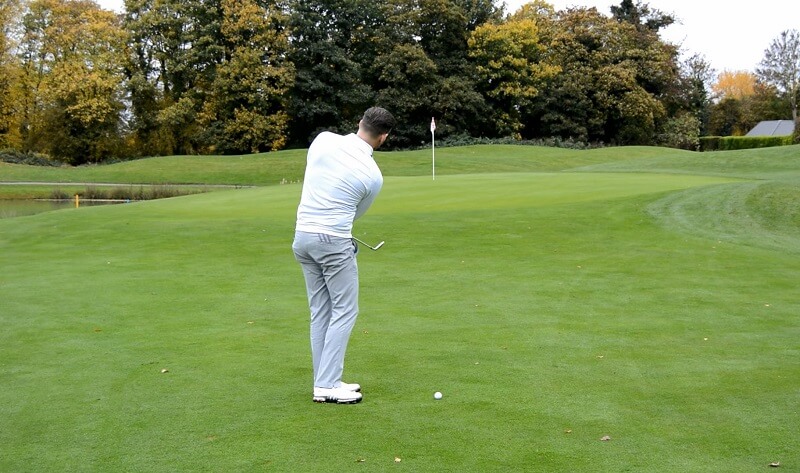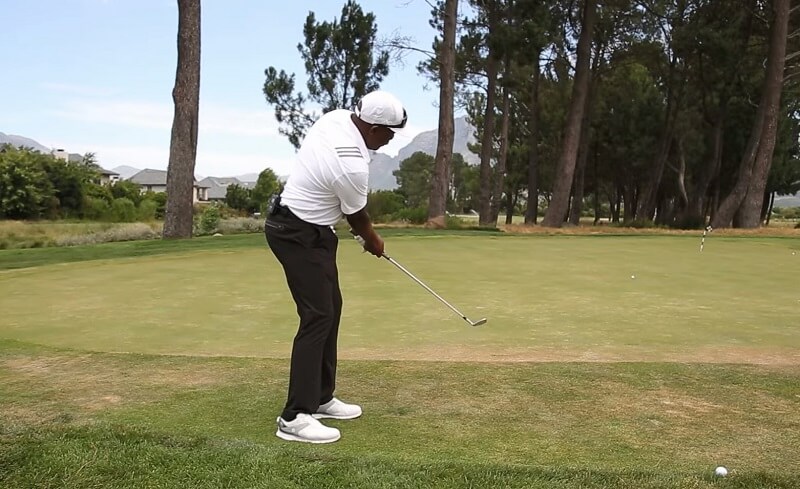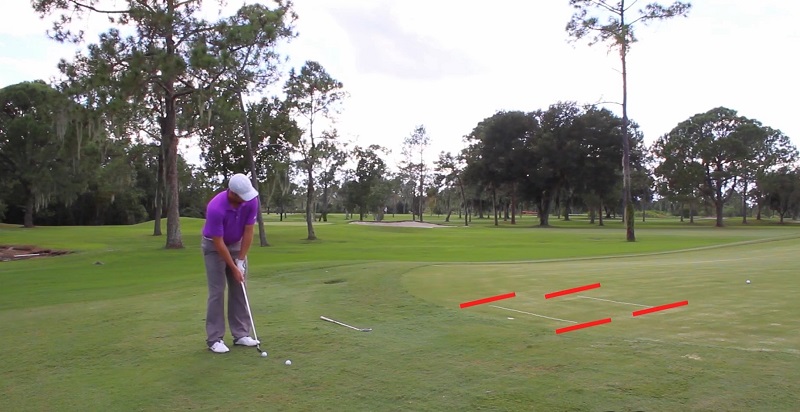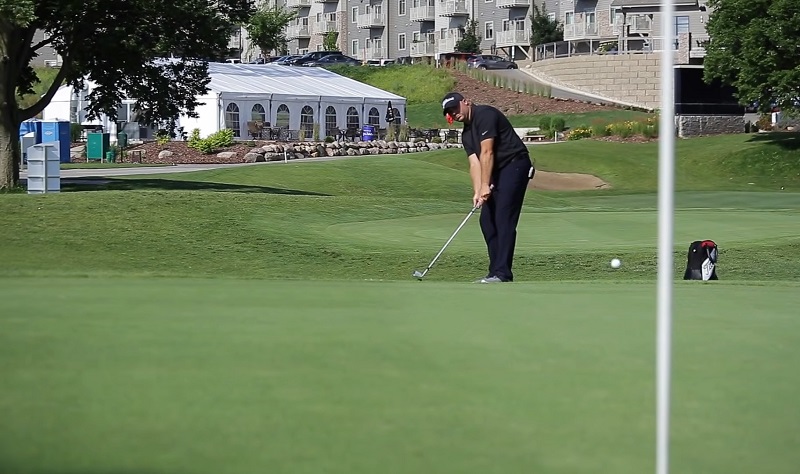The Bump and Run is a versatile and effective golf shot used to control the ball’s trajectory, distance, and spin. It is essential for short game play due to its ability to get the ball close to the hole quickly. This article will explain how to properly execute a Bump and Run, as well as some of its advantages and disadvantages.
What Is A Bump And Run In Golf?
Unlike other shots that require risky swings and high-lofted clubs, the bump and run shot guarantees a slow-spinning, low-to-the-ground trajectory.
With this shot’s precision, errors like chunks and skulls become a thing of the past. It is a simple shot that can be executed using various clubs, providing flexibility to adjust to different situations around the green.
Moreover, by landing the ball halfway towards the target and letting it roll towards the hole, the bump and run shot grants golfers a chance to get close to the green and one-putt their way to victory.
What Are The Advantages Of Using A Bump And Run Shot?

The biggest advantage of the bump and run shot is that it is a very low-risk shot. The ball flies low to the ground, so any uneven surfaces you may encounter are unlikely to affect your ball’s performance. Furthermore, with a consistent swing, this shot ensures accuracy and control over the ball’s trajectory and spin. Additionally, due to the low spin rate, you can capitalize on any backspin generated by the shot which allows for more control over distance and accuracy.
Finally, with a bump and run shot, you’ll have an easier time gauging your distances since it requires consistent tempo each time. This makes it useful when playing in different areas of the green, as you can easily adjust your swing to reach different targets.
When Should You Use Bump And Run?
The bump and run shot is a valuable tool for golfers around the greenside area, especially when there is ample room between you and the hole with little trouble in between. This shot offers control over the club speed, making it easier to navigate.
The bump and run is particularly effective on flat terrain where the golf ball can easily bump the green and maintain its proper line. A lob wedge may be viable if one short sides oneself, yet it’s important to consider the rough between you and the spin.
If the ground is clean and short between you and the spin, the bump and run shot will prove to be the best option.
How To Execute A Bump And Run Shot?

The first step to executing a bump and run shot is to select the right club. As mentioned earlier, various clubs can be used for this shot, but the choice ultimately depends on how far the ball needs to travel. A sand wedge or lob wedge is usually best for short distances, while a 9-iron or 8-iron can be used for longer distances.
Once the club is selected, the ball position is another key factor to consider. For right-handed players, the ball should be slightly back in your stance, closer to your right foot than your left. Why? Because this setup allows you to hit down on the ball, producing the coveted backspin that can help your ball travel further with more accuracy. However, it’s important to note that this does not apply to every shot.
Hit the ball with a descending blow and ensure that your follow-through is low to the ground like you’re punching a button on the green. Let the club take its natural path while keeping your body facing your target throughout the shot. Your goal here is to hit down slightly on the ball, allowing it to roll toward the hole.
What Golf Club Is Best For Bump And Run?
The golf club that is best for a bump and run shot all depends on the situation. Generally speaking, a sand wedge or lob wedge can be used for short distances, while a 9-iron or 8-iron can be used for longer distances.
When choosing the club to use, it’s important to consider various factors such as the line of the ball, distance to the target, and terrain. For example, if you find yourself with an uneven lie on a slope, a higher-lofted club (such as a sand wedge or lob wedge) may be useful in providing better control over the ball’s flight and spin.
Additionally, the position of the ball in your stance is also important when choosing a club. For right-handed players, the ball should be slightly back in your stance, closer to your right foot than your left for maximum control and accuracy.
Overall, it’s best to experiment with different clubs until you find one that works best for you in different situations.
How Far Can You Hit A Bump And Run In Golf?

The distance you can hit a bump and run shot in golf, there are multiple factors that come into play. One of the most significant factors is the club you use and your skill level.
As the rule of thumb goes, the distance covered by the shot is about nine-third carry and two-thirds roll. However, the bump phase of the shot can vary depending on the club used.
For instance, a Gap wedge or a 60-degree golf wedge can result in a slightly more elevated bump phase. Keep in mind that the ball’s bounce when it hits the green will also impact the total distance it rolls. Additionally, the position of the ball in your stance is also important. For right-handed players, the ball should be slightly back in your stance, closer to your right foot than your left for maximum control and accuracy.
When it comes to distance, practice makes perfect. As you become more experienced, you’ll be able to judge the distance of a shot better and know exactly when to use which club for maximum results. With practice, you’ll soon be able to hit bump and run shots confidently and accurately anywhere on the course.
Practice Drills for Mastering the Bump and Run
Target Distance Variation Drill
Drill helps you gain accuracy and control with the bump and run shot. Set up three targets at different distances, then practice hitting each one using a mid-iron. Try to land the ball near where the target is, so you can get an idea of how far your shots travel.
Obstacle Simulation Drill
Set up obstacles such as bunkers, trees, and water hazards, then practice playing bump and run shots over or around them. Adapt your bump and run technique to navigate these challenges successfully. This drill will help you develop course management skills and become more confident in your shot-making ability.
Club Selection Experimentation Drill
Try a few clubs, including wedges and mid-irons. Take practice swings with each club and see how the trajectory of the ball changes. Experiment with various clubs to understand which one works best for your bump and run shot in different situations. This process will help you gain confidence in choosing the right club for certain shots.
Distance Control Practice
Developing precise distance control with your bump and run shots is key to improving your golf game. This requires practice and experimenting with different clubs, as well as course management skills. Positioning the ball slightly back in your stance, closer to your right foot than your left, will also help control the distance of the shot. With practice and dedication, your ability to gauge the necessary power and finesse to achieve desired results, helping you consistently control the distance of your shots.
Uphill and Downhill Challenges
Incorporating uphill and downhill lies into your bump and run practice can be challenging, but essential for improving your golf game. When playing a bump and run shot on an uphill lie, you’ll need to focus on keeping the ball low by applying more power. This will help reduce the risk of losing control and achieve greater accuracy with your shot. On the other hand, when playing on a downhill lie, you’ll need to focus on keeping the ball high and applying finesse with your shot.
Limbo Drill
Set up multiple hurdles of varying heights and distances, then practice hitting shots over them. This will help you develop a greater control of your ball’s trajectory while also giving you an idea of what obstacles you can successfully play around or over during a game. This drill is great for improving your accuracy with the bump and run shot.
These drills are fundamental for mastering the bump and run shot and essential for improving your golf game. With consistent practice, experimentation, course management skills, and finesse, you’ll soon be able to confidently execute bump and run shots anytime you’re on the course!
Conclusion
The bump and run shot is an incredibly useful tool for golfers around the world. It requires a certain skill level and understanding of various factors such as club selection, ball position in your stance, and terrain. Practicing can help you to perfect this shot and take your game to the next level. So get out there, practice your bump and run, and improve your golf game!


